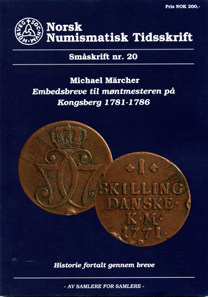by Ursula Kampmann
translated by Annika Backe
July 21, 2016 – As a preliminary point, my Danish is pretty bad – sometimes I even mistake it for Norwegian. But with the help of a German-Danish dictionary and Google Translate you might well venture on the official letters of mint master Branth, who held this function in the Kongsberg Mint from 1781 to 1786.
Michael Märcher, Embedsbreve til montmesteren pa Kongsberg 1781-1786. Norsk Numismatisk Tidsskrift, Smaskrift 20 (2016). 127 p. with some color illustrations. 17 x 24cm. Paperback. Adhesive binding. ISSN 1894-2237. 200 NOK (ca. 21 euros) + postage and packaging.
Michael Märcher, probably one of the most knowledgeable experts on minting technology in early modern times, presents another piece of the puzzle, therewith adding to the picture of what we know about the functioning of a mint at the transition from the traditional to the industrial production. He transcribed and translated the official letters of mint master Branth, who was responsible for coin minting in Kongsberg, today belonging to Denmark, into modern Danish.
Kongsberg possessed important silver mines which in 1769 – thus roughly a decade before master Branth wrote his letters – were exploited by more than 4,000 miners. With its population of about 8,000 citizens, Kongsberg, after Bergen, was the second-largest city of Norway. And it was the site of an important mint whose plan opens Michael Märcher’s book. This plan is impressive due to the mere size of the premises and the number of rooms with the different functions that can be exactly determined through the accompanying legend.
Why do I introduce a book here that most of the readers (unfortunately) will never be able to read? Very simple, it is because I want to stress again how important it is to access the sources particularly when it comes to numismatics of early modern times. Only through these sources we can get a clear picture of how mints worked during the 18th and 19th centuries. Some subsidiary aspects of numismatics can only be grasped when you know the technical background. And, to date, this is a field we know woefully little about – even though the archives contain so much source material that only needs to be accessed in order to round out the scientific mosaic of ‘the mint’.
You can order special issue no. 20 of the Norsk Numismatisk Tidsskrift, published by collectors for collectors – as indicated by the motto –, for 200 Norwegian kroner plus postage by writing an email.




